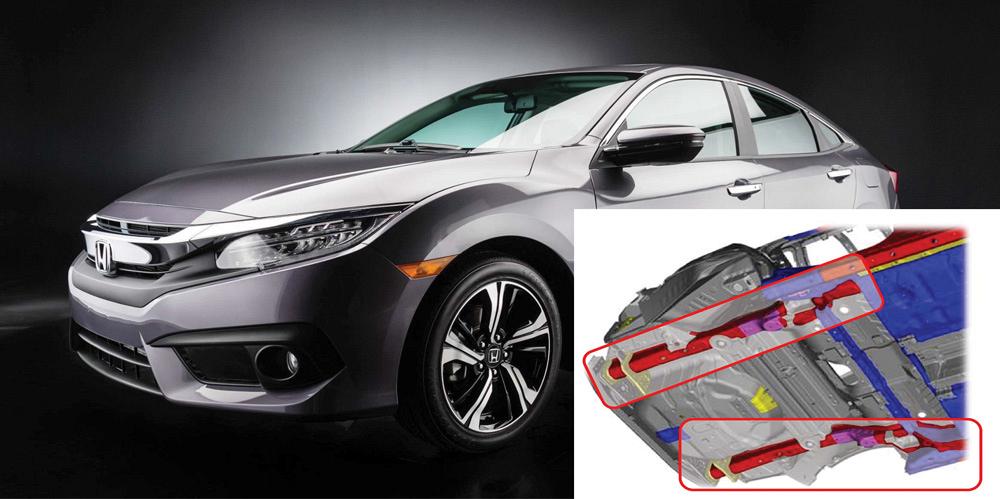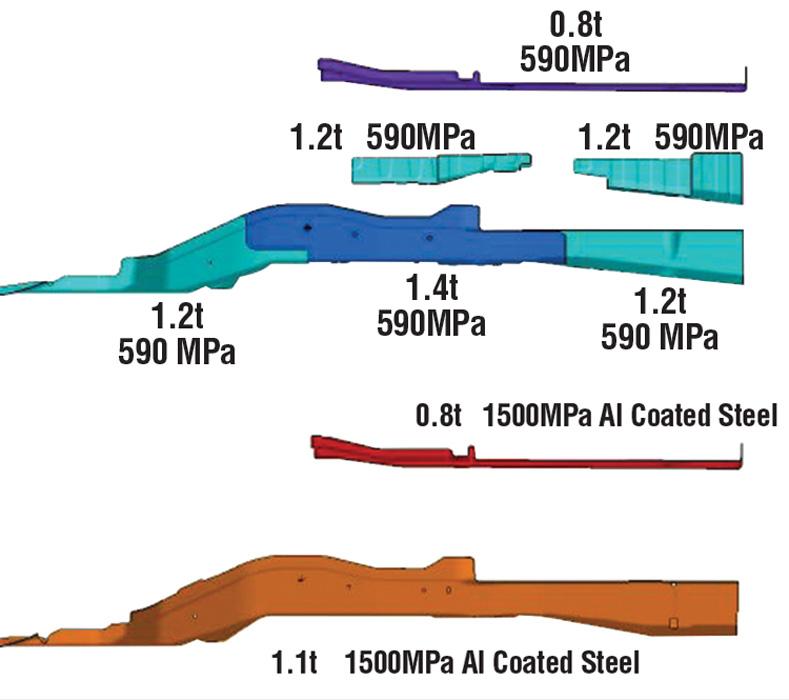R&D Director North America
- FMA
- The Fabricator
- FABTECH
- Canadian Metalworking
Categories
- Additive Manufacturing
- Aluminum Welding
- Arc Welding
- Assembly and Joining
- Automation and Robotics
- Bending and Forming
- Consumables
- Cutting and Weld Prep
- Electric Vehicles
- En Español
- Finishing
- Hydroforming
- Laser Cutting
- Laser Welding
- Machining
- Manufacturing Software
- Materials Handling
- Metals/Materials
- Oxyfuel Cutting
- Plasma Cutting
- Power Tools
- Punching and Other Holemaking
- Roll Forming
- Safety
- Sawing
- Shearing
- Shop Management
- Testing and Measuring
- Tube and Pipe Fabrication
- Tube and Pipe Production
- Waterjet Cutting
Industry Directory
Webcasts
Podcasts
FAB 40
Advertise
Subscribe
Account Login
Search
How 2016 Car of the Year Honda Civic maneuvered around AHSS obstructions
Breakthrough “softzone” hot-stamping technology aids 20 percent weight-downs in rear frame rails
- By Paul J. Belanger
- October 4, 2016
- Article
- Bending and Forming

Honda used Gestamp’s in-die “softzone” hot-stamping process to form strategic zones of the 2016 Civic sedan’s rear frame rails to 1,500 megapascal (shown in red), while cooling other zones (shown in pink) at a different pace to render them to a lower tensile strength to satisfy crush mode and performance targets.
Editor’s Note: This article was adapted from the authors’ presentations at the 2015 and 2016 Great Designs in Steel conferences,m sponsored by the Steel Market Development Institute, in Livonia, Mich. The entire presentations can be accessed at www.autosteel.org.
The 2025 corporate average fuel economy (CAFE) 54.5-MPG standards are challenging engineers to make significant weight reductions in the white body.
Automaker Honda responded to these lightweighting challenges, starting with weight reductions in its 2016 Civic® rear frame rails. The goal of the project was to reduce weight and mass by 20 percent while maintaining safety performance.
The 2016 Honda Civic sedan was awarded North American Car of the Year by the Automotive Press Association; 2016 AutoGuide Car of the Year; 2016 Kelley Blue Book Best Buy Award: Overall Winner; and also 2016 Kelley Blue Book Best Value Brand. Lightweighting efforts that helped garner those awards were also recognized by the Steel Market Development Institute’s Automotive Excellence Award at the 15th annual Great Designs in Steel seminar in April.
Rear Frame Design Concept
The project goal was to reduce the rear frame mass by a fifth compared to previous models without jeopardizing the necessary crush mode and safety performance.
Managing energy during high-speed rear crashes poses significant challenges because of the package complexity at the vehicle’s rear. During the planning phase of the project, Honda engineers investigated three different ways to manage crash energy: a simple bend, axial crush, and three-point bending (see Figure 1). Balancing the project goals, efficiency, and system complexity, engineers chose a three-point bend design. The three-point bend system is very stable while also achieving a high degree of energy absorption. Realizing the concept’s efficiency led to the application of tailor-tempering technology.
Complex Versus Simplified Approach
One approach to reducing rear frame mass was to simplify the rear frame rail design. The previous Civic rear frame required many small pieces to be stamped and spot welded into the main frame rail to achieve the desired safety performance. Local stiffeners (small, steel, stamped stiffener parts that are attached to the main frame rail using spot resistance welds) and separate parts were required for mode control and energy absorption. This resulted in a high spot weld count, a high piece cost, and weld line investment.
In a series of design changes, the number of the rear frame assembly components was consolidated from six to two (see Figure 2).
Hot Stamping With In-die Controlled Cooling
However, simplifying the design required a different forming approach. First, Honda used hot stamping to maneuver around springback, tearing, and other problems associated with forming AHSS. The automaker used Gestamp’s in-die softzone technology to produce sections with tailored properties (soft zones).
Softzone technology is a process by which the cooling in the forming and quenching process of the hot-stamping operation is controlled through use of thermally stabilized tools. This allows the stamper to achieve tailored zones with microstructures of lower strength and greater ductility than the traditional full martensitic microstructure achieved with traditional hot stamping.
By controlling the microstructure in select areas of the part, the stamper can realize targeted deformation zones or zones with greater elongation in specific areas, while the remainder of the part can be at the full ultrahigh strength. Using these tailor-tempered zones, designers can target select areas where the lower-strength metal can best be located while maintaining ultrahigh tensile strength in the rest of the part. Tailor-tempering can be applied to small areas anywhere on the part.

Figure 1
Three distinct bends are characterized by the increase and decrease of load during frame crush. The three-point bend mode gives consistent safety performance, while maintaining a high level of energy absorption.
The technology allowed Honda engineers to render some sections of the rail at 1,500 megapascals (MPa) and other sections with lower tensile strength to serve as crush energy absorbers (see Figure 3).
Using this tailor-tempering approach, they were able to achieve the desired frame crush mode without local stiffeners or additional parts. This design saved both weight and cost by eliminating the small stampings and reducing spot welds.
As a result of the redesign and use of in-die softzone hot stamping, the team was successful in achieving its 20 percent weight reduction goal and full realization of the rear frame crush mode in the 2016 Honda Civic (see Figure 4).
Beyond the Rear Frame Rails
Because the tailor-tempering concept was successful in forming the rear frame rails, it has now been extended to its use in other structural components. Hot stamping with in-die softzone, controlled-cooling technology is now also being employed to form side pillars in the Honda Civic. The use of hot stamping in the 2016 model increased from 1 to 14 percent from the previous model.
Body Construction Material Grades in 2016 Honda Civic
The 2016 Honda Civic’s body construction comprises 58 percent high-strength steel (HSS), including 26 percent ultrahigh-strength steel. Steel parts are color-coded to indicate their tensile strength in megapascals (MPa).
High-strength steel is defined as any steel with a tensile strength of 440 MPa or higher. The center pillar stiffener and rear frame are constructed of 1,500-MPa steel with soft zones to enable crash performance. Other structural components made of HSS include the front inner upper pillar, front side frame extension, roof front rail, roof side stiffener, and side sill reinforcement.
About the Author
Paul J. Belanger
1600 Harmon Road
Auburn Hills, MI 48326
248-729-6363
subscribe now

The Fabricator is North America's leading magazine for the metal forming and fabricating industry. The magazine delivers the news, technical articles, and case histories that enable fabricators to do their jobs more efficiently. The Fabricator has served the industry since 1970.
start your free subscription- Stay connected from anywhere

Easily access valuable industry resources now with full access to the digital edition of The Fabricator.

Easily access valuable industry resources now with full access to the digital edition of The Welder.

Easily access valuable industry resources now with full access to the digital edition of The Tube and Pipe Journal.
- Podcasting
- Podcast:
- The Fabricator Podcast
- Published:
- 04/16/2024
- Running Time:
- 63:29
In this episode of The Fabricator Podcast, Caleb Chamberlain, co-founder and CEO of OSH Cut, discusses his company’s...
- Trending Articles
AI, machine learning, and the future of metal fabrication

Employee ownership: The best way to ensure engagement

Steel industry reacts to Nucor’s new weekly published HRC price

How to set a press brake backgauge manually

Capturing, recording equipment inspection data for FMEA

- Industry Events
16th Annual Safety Conference
- April 30 - May 1, 2024
- Elgin,
Pipe and Tube Conference
- May 21 - 22, 2024
- Omaha, NE
World-Class Roll Forming Workshop
- June 5 - 6, 2024
- Louisville, KY
Advanced Laser Application Workshop
- June 25 - 27, 2024
- Novi, MI



























